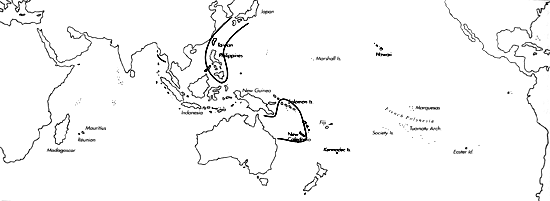Range: Japan to Philippines; Solomon Is., New Caledonia, and Queensland; Andaman Sea off Burma.
Description: Moderately large to large, moderately solid to solid. Last whorl ventricosely conical or conical; outline slightly convex at subshoulder area, straight below. Shoulder angulate. Spire unusually high and stepped, outline straight. Larval shell of about 3.25 whorls, maximum diameter about 1 mm. First 5-12 postnuclear whorls tuberculate. Teleoconch sutural ramps flat to slightly concave, with 1 increasing to 3-4 spiral grooves. Shells with an almost smooth last whorl intergrade with shells having variably spaced, axially striate spiral grooves from base to shoulder, separated by sometimes granulose ribbons.
| Shell Morphometry | ||
|---|---|---|
| L | 60-102 mm | |
| RW | 0.14-0.30 g/mm | |
| (L 60-80 mm) | ||
| RD | 0.54-0.60 | |
| PMD | 0.81-0.91 | |
| RSH | 0.37-0.43 | |
Ground colour white. Last whorl with interlaced wavy brown axial lines and a continuous or interrupted brown spiral band on each side of centre that contains variously shaped white markings and spiral rows of alternating white spots and brown axial dashes. Larval whorls grey. Early teleoconch sutural ramps immaculate, later ramps with brown axial blotches of varying size. Aperture white.
Periostracum yellow, thin, translucent, and smooth.
Habitat and Habits: In 100-400 m.
Discussion: C. excelsus cannot be mistaken for any other Conus species. T. nakayasui refers to a variant with reduced colour pattern; such specimens intergrade with extensively patterned ones.

C. excelsus range map
This section contains verbatim reproductions of the accounts of 316 species of Conus from the Indo-Pacific region, from Manual of the Living Conidae, by Röckel, Korn and Kohn (1995). They are reproduced with the kind permission of the present publisher, Conchbooks.
All plates and figures referred to in the text are also in Röckel, Korn & Kohn, 1995. Manual of the Living Conidae Vol. 1: Indo-Pacific Region.
The range maps have been modified so that each species account has it own map, rather than one map that showed the ranges of several species in the original work. This was necessary because each species account is on a separate page on the website and not confined to the order of accounts in the book.